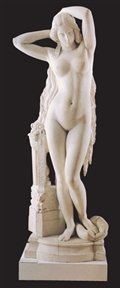James Pradier, Nyssia, 1848.
Marble, h. : 176 cm.
Musée Fabre, Montpellier.
Jean-Jacques Pradier, called James Pradier
(Geneva, 1790 – Bougival, 1852)
The Swiss-born French sculptor, James Pradier, was a member of the French Academy, and a popular sculptor of the pre-Romantic period, representing in France the drawing-room Classicism which Canova illustrated in Rome. He was born in Geneva, but at the age of seventeen left for Paris, where his brother worked as an engraver. In 1813 he won the Prix de Rome, and so departed for Italy.
After spending four years in Rome, from 1814 to 1818, he studied with Ingres in Paris, and soon became a friend of the Romantic poets Alfred de Musset, Victor Hugo and Théophile Gautier. His studio became a meeting-place for Romantic thinkers, presided over by his mistress Juliette Drouet, who was the model for Pradier’s statue representing Strasbourg in the Place de la Concorde. Between 1871 and 1918, when the region of Alsace-Lorraine was lost to Germany, this statue was frequently draped in mourning crêpe and decorated with wreaths. It is a typical example of Pradier’s sensual classical sculptures of women. His works, showing neo-Classical influence, are filled with an eroticism that made his Satyr and Bacchante the centre of a scandal during the Salon in 1834. Louis-Philippe’s government refused the work, which was eventually sold to Count Anatole Demidoff and taken to his palazzo in Florence, though it was later returned to Paris. Louis-Philippe was a great admirer of Pradier’s work, though the sculptor was famously apolitical, and adapted to the regime of the time. He also provided official works such as figures for the Arc de Triomphe, the church of the Madeleine and les Invalides.
His work, very famous in his time, has now been largely forgotten. However, in 1846 Gustave Flaubert wrote: “This is a great artist, a true Greek, the most antique of all the moderns.”
